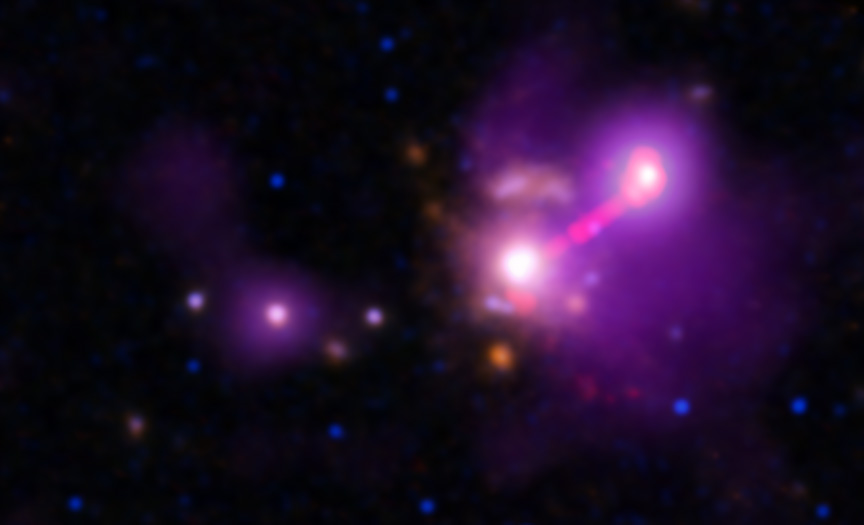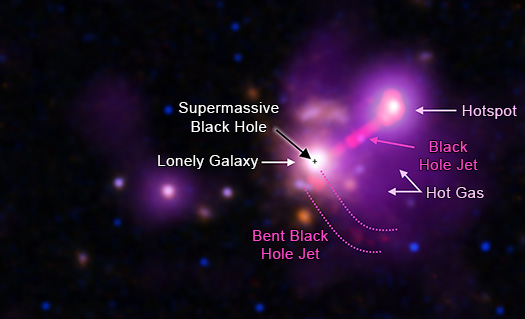A large galaxy spewing a black hole–powered jet might have eaten its neighbors, leaving it on its own.

X-ray: NASA / CXC / Univ. of Torino / V. Missaglia et al.; Optical: NASA / ESA / STScI & International Gemini Observatory / NOIRLab / NSF / AURA; Infrared: NASA / ESA / STScI; Radio: NRAO / AUI / NSF
When the universe was only a third its current age, most galaxy clusters were still assembling. Now, observations reveal that one of these was already in the end game. This so-called fossil group consists of only one galaxy, because it has already eaten all of its companions.
Astronomers have long studied 3C 297, a giant elliptical galaxy that hosts a supermassive black hole and a powerful black hole–powered jet extending some 140,000 light-years into intergalactic space. Its light has traveled 9.2 billion light-years to Earth.
The power of such galaxies — gravitational and otherwise — is known to influence their environment. So Valentina Missaglia(University of Torino, Italy) and her colleagues set out to explore its environs in detail, publishing their results in The Astrophysical Journal.
Their Chandra X-ray Observatory images revealed million-degree gas surrounding the galaxy, the kind of gas halo typical of groups with many members. Features in the two-lobed jet flying out of the galaxy’s center also indicate the breadth of the gas halo. One lobe is bent, as seen previously in radio observations, and the other has crashed into surrounding gas, lighting up in X-rays. Both of these features point to a giant gas halo — and thus many companions.
“We were expecting to detect a dozen galaxies similar to the Milky Way,” Missaglia says.
But spectroscopic measurements with the Gemini Observatory in Hawai‘i show that none of the galaxies around 3C 297 are anywhere near it — they’re only aligned by chance. Any companions that the observations might have missed would have to be 10 times fainter than our own, putting them on the order of dwarf galaxies.

X-ray: NASA / CXC / Univ. of Torino / V. Missaglia et al.; Optical: NASA / ESA / STScI & International Gemini Observatory / NOIRLab / NSF / AURA; Infrared: NASA / ESA / STScI; Radio: NRAO / AUI / NSF
The most likely scenario that would explain all of the observations is that 3C 297 was a galaxy group, but in just a few billion years, managed to assimilate them all. If this group is a fossil, it’s a record-breaker, residing in a universe just 4.5 billion years old. The previous record-holder existed 5.8 billion years after the Big Bang.
“This doesn’t break our ideas of cosmology,” says coauthor Mischa Schirmer (Max Planck Institute for Astronomy, Germany), “but it begins to push the limits on how quickly both galaxies and galaxy clusters must have formed.”
Jaewon Yoo (Korea Institute for Advanced Study), who wasn’t involved in the current study, says that a fossil forming as early as 3C 297 would be extremely rare. To confirm the find, she’d want to see a more complete census of the galaxies around it.
It could be that we’re seeing a fossil group in an earlier stage of evolution, Yoo says. Unlike other fossil groups, whose X-ray halos are unremarkable, the halo around 3C 297 “looks somewhat disturbed,” she notes. That could be because of a recent merger, meaning the galaxy has only just finished absorbing its companions.
 2
2









Comments
Yaron Sheffer
March 21, 2023 at 10:08 am
Dr Yoo is absolutely right. This study is incomplete. Half of the sources near 3C 297 that were observed did not yield any redshift information (Table 2 of published paper). Am baffled as to why there is no mention nor redshift for the bright object to the left of the field. Could it be a neighbor interactor?
The Chandra image shows a nice ram pressure shape around 3C 297, which could have bent one of the jets.
Finally, forget "infrared" from Hubble. What I'd like to see is this field shot by Webb 🙂
You must be logged in to post a comment.
MeadeLX200
March 24, 2023 at 5:01 pm
This is an amazing study but it seems to be incomplete as previously noted. YES...send in the JWST crew and COMPLETE that spectroscopy study. Keep up the GREAT work! Dean Janson President and co-founder of The People's Astronomy club of Boise Idaho.
You must be logged in to post a comment.
You must be logged in to post a comment.